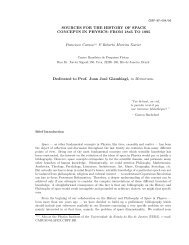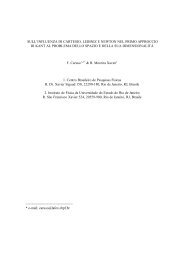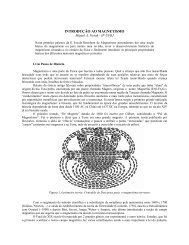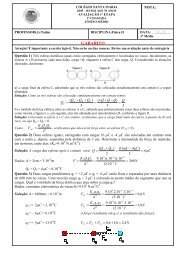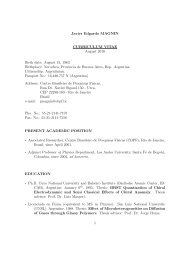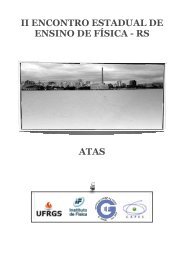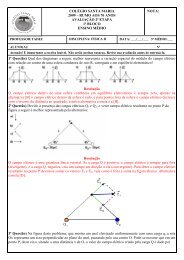Primordial non-Gaussianity in the cosmological perturbations - CBPF
Primordial non-Gaussianity in the cosmological perturbations - CBPF
Primordial non-Gaussianity in the cosmological perturbations - CBPF
Create successful ePaper yourself
Turn your PDF publications into a flip-book with our unique Google optimized e-Paper software.
A given comov<strong>in</strong>g scale λ is <strong>the</strong>refore projected on <strong>the</strong> last-scatter<strong>in</strong>g surface sky on an angular scale<br />
λ<br />
θ , (158)<br />
(τ0 − τls)<br />
where we have neglected t<strong>in</strong>y curvature effects. Consider now that <strong>the</strong> scale λ is of <strong>the</strong> order of<br />
<strong>the</strong> comov<strong>in</strong>g sound horizon at <strong>the</strong> time of last-scatter<strong>in</strong>g, λ ∼ csτls, where cs 1/ √ 3 is <strong>the</strong> sound<br />
velocity at which photons propagate <strong>in</strong> <strong>the</strong> plasma at <strong>the</strong> last-scatter<strong>in</strong>g. This corresponds to an<br />
angle<br />
τls<br />
θ cs<br />
(τ0 − τls)<br />
τls<br />
cs<br />
τ0<br />
, (159)<br />
where <strong>the</strong> last passage has been performed know<strong>in</strong>g that τ0 ≫ τls. S<strong>in</strong>ce <strong>the</strong> universe is MD from <strong>the</strong><br />
time of last-scatter<strong>in</strong>g onwards, <strong>the</strong> scale factor has <strong>the</strong> follow<strong>in</strong>g behaviour: a ∼ T −1 ∼ t 2/3 ∼ τ 2 ,<br />
where we have made use of <strong>the</strong> relation (139). The angle θHOR subtended by <strong>the</strong> sound horizon on<br />
<strong>the</strong> last-scatter<strong>in</strong>g surface <strong>the</strong>n becomes<br />
θHOR cs<br />
1/2 T0<br />
Tls<br />
∼ 1 ◦ , (160)<br />
where we have used Tls 0.3 eV and T0 ∼ 10 −13 GeV. This corresponds to a multipole ℓHOR<br />
ℓHOR = π<br />
θHOR<br />
200. (161)<br />
From <strong>the</strong>se estimates we conclude that two photons which on <strong>the</strong> last-scatter<strong>in</strong>g surface were<br />
separated by an angle larger than θHOR, correspond<strong>in</strong>g to multipoles smaller than ℓHOR ∼ 200 were<br />
not <strong>in</strong> causal contact. On <strong>the</strong> o<strong>the</strong>r hand, from Fig. 6 it is clear that small anisotropies, of <strong>the</strong><br />
same order of magnitude δT/T ∼ 10 −5 are present at ℓ ≪ 200. We conclude that one of <strong>the</strong> strik<strong>in</strong>g<br />
features of <strong>the</strong> CMB fluctuations is that <strong>the</strong>y appear to be <strong>non</strong>causal. Photons at <strong>the</strong> last-scatter<strong>in</strong>g<br />
surface which were causally disconnected have <strong>the</strong> same small anisotropies! The existence of particle<br />
horizons <strong>in</strong> <strong>the</strong> standard cosmology precludes expla<strong>in</strong><strong>in</strong>g <strong>the</strong> smoothness as a result of microphysical<br />
events: <strong>the</strong> horizon at decoupl<strong>in</strong>g, <strong>the</strong> last time one could imag<strong>in</strong>e temperature fluctuations be<strong>in</strong>g<br />
smoo<strong>the</strong>d by particle <strong>in</strong>teractions, corresponds to an angular scale on <strong>the</strong> sky of about 1 ◦ , which<br />
precludes temperature variations on larger scales from be<strong>in</strong>g erased.<br />
To account for <strong>the</strong> small-scale lump<strong>in</strong>ess of <strong>the</strong> universe today, density <strong>perturbations</strong> with<br />
horizon-cross<strong>in</strong>g amplitudes of 10 −5 on scales of 1 Mpc to 10 4 Mpc or so are required. As can<br />
be seen <strong>in</strong> Fig. 5, <strong>in</strong> <strong>the</strong> standard cosmology <strong>the</strong> physical size of a perturbation, which grows as <strong>the</strong><br />
scale factor, beg<strong>in</strong>s larger than <strong>the</strong> horizon and relatively late <strong>in</strong> <strong>the</strong> history of <strong>the</strong> universe crosses<br />
<strong>in</strong>side <strong>the</strong> horizon. This precludes a causal microphysical explanation for <strong>the</strong> orig<strong>in</strong> of <strong>the</strong> required<br />
density <strong>perturbations</strong>.<br />
From <strong>the</strong> considerations made so far, it appears that solv<strong>in</strong>g <strong>the</strong> shortcom<strong>in</strong>gs of <strong>the</strong> standard<br />
Big Bang <strong>the</strong>ory requires two basic modifications of <strong>the</strong> assumptions made so far:<br />
42




